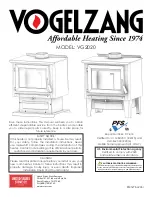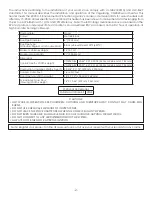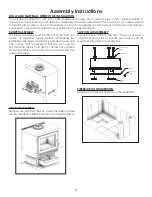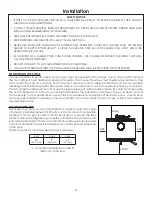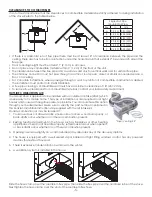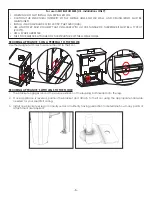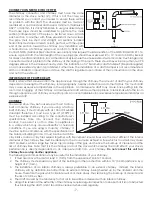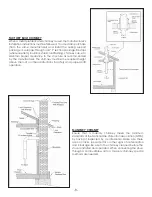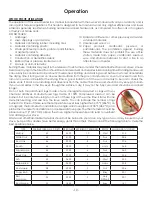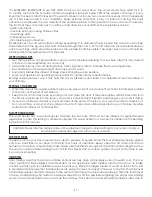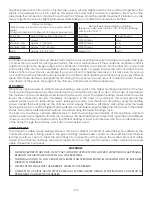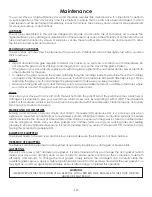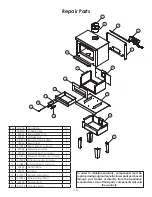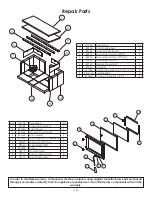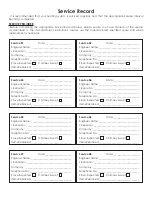
-5-
CLEARANCES TO COMBUSTIBLES
It is of utmost importance that the clearances to combustible materials be strictly adhered to during installation
of the stove. Refer to the tables below.
•
If there is a Horizontal run of flue pipe there must be at lease 18” of clearance between the pipe and the
ceiling. There also has to be floor protection under the horizontal run that extends 2” beyond each side of the
flue pipe.
•
Floor to ceiling height must be at least 7’ (2.13 m) in all cases.
•
Do not place any combustible material within 4’ (1.2 m) of the front of the unit.
•
The clearance between the flue pipe and a wall are valid only for vertical walls and for vertical flue pipe.
•
The chimney connector must not pass through an attic or roof space, closet or similar concealed space, a
floor, or a ceiling.
•
For Canadian installations, where passage through a wall, or partition of combustible construction is desired,
the installation must conform to CAN/CSA-B365.
•
A flue pipe crossing a combustible wall must have a minimum clearance of 18” (457.2 mm).
•
To reduce flue clearances from combustible materials, contact your local safety department.
Single Wall Pipe
(Double Wall Pipe)
Key
in
mm
A
15 (12) 381 (305)
B
18 (18) 458 (458)
C
19 (16) 483 (407)
D
29 (29) 737 (737)
E
12 (12) 305 (305)
F
22 (22) 559 (559)
D
B
A
C
E
F
E
D
B
A
C
E
F
E
Slide the hose clamp over the aluminium flex pipe. Then slide the flex pipe over the air intake tube of the stove.
Next tighten the hose clamp over the end of the aluminium flex hose.
OUTSIDE COMBUSTION AIR
Your wood stove is approved to be installed with an outside air intake (4FAK) which
is necessary for a mobile home. This type of installation is also required in air tight
houses and houses with negative pressure problems. You can purchase this option
through your heater dealer. Make sure to specify the part number mentioned in
this booklet. Installation instructions are supplied with the air intake kit.
Outside combustion air may be required if:
1. Your stove does not draw steadily, smoke roll-out occurs, wood burns poorly, or
back-drafts occur whether or not there is combustion present.
2.
Existing fuel-fired equipment in the house, such as fireplaces or other heating
appliances, smell, do not operate properly, suffer smoke roll-out when opened,
or back-drafts occur whether or not there is combustion present.
3.
Opening a window slightly on a calm (windless) day alleviates any of the above symptoms.
4.
The house is equipped with a well-sealed vapor barrier and tight fitting windows and/or has any powered
devices that exhaust house air.
5.
There is excessive condensation on windows in the winter.
6.
A ventilation system is installed in the house.
“Dryer Venting Kit”
Содержание VOGELZANG VG2020
Страница 17: ...17 Notes...
Страница 18: ...18 Notes...

